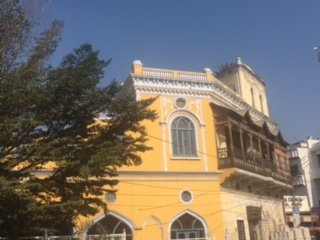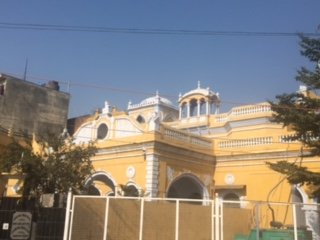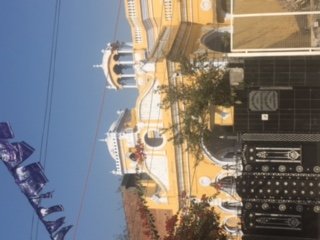http://www.telegraph.co.uk/culture/art/9646841/What-did-the-Mughals-do-for-us.html
http://www.telegraph.co.uk/culture/...91/The-British-Library-The-Mughal-Empire.html
In the summer of 1617, Emperor Jahangir — decked out in the finest silks and “rubies as great as walnuts” – marked his 48th birthday with a stunning ceremony in the palace gardens at Agra. “Here attended all the nobility, sitting about on carpets, until the King came” to be weighed on a huge set of golden scales.
The ritual is reported by enthralled onlooker Sir Thomas Roe, the British ambassador, in his Journal of the Mission to the Mughal Empire. Jahangir was weighed against bags of silver, gold and jewels, with the equivalent of his weight then distributed to the poor. Here was an emperor literally worth his weight in gold; or, as Roe put it, “the treasury of all the world”.
The ambassadorial view of the Mughals has persisted down the centuries. The dynasty – which ruled most of Asia’s subcontinent between 1526 and the early 19th century – has traditionally been seen as one of sensualist extravagance. Particularly in Britain, where historians have played up the administrative achievements in India of the Raj years (roads, railways, schools) in contrast to the hookahs and harems of the preceding Mughal age.
A new exhibition at the British Library, though, plans to set the record straight; to reconsider the Mughal Empire as one of the most progressive in history. We know about the architecture, of course: most famously, the Taj Mahal, Emperor Shah Jahan’s love poem in stone for his late wife Mumtaz, and the other garden tombs built to anticipate and replicate paradise.
Yet, of perhaps greater relevance is the multicultural society the Mughals created avant la lettre. A Turkic-Mongol race, hailing from central Asia, the Mughals were invading Muslims who came to control a mostly Hindu population. Their religious tolerance manifested itself in various ways – especially under the third ruler Akbar (1556-1605), who would surely figure in any “Greatest Emperors of all Time” list.
The tax burden on non-Muslims was eased; the authority of regional Hindu rulers was left intact; and forcible conversion to Islam was outlawed. Akbar also took Hindu wives, as well as introducing the legendary Ibadat Khana (House of Worship), where people of all faiths (Islamic, Hindu, Jain, Sikh, Christian, atheist, even chilli worshippers) were encouraged to debate on matters religious and philosophical.
The good times didn’t last, however, and the reign of the militantly orthodox Aurangzeb began the Mughals’ steady decline – his death in 1707 heralding deadly squabbles for the throne that saw rivals blinded with hot needles and forced off cliffs on their elephants.
Artistic activity followed a similar pattern of rise and fall. Founded in the 1550s, the Mughal painting school comprised of Indian artists, taught by Persian masters and influenced by Renaissance prints arriving as gifts to the emperor from European envoys and missionaries.
A sophisticated stylistic fusion resulted, visible in the many illustrated manuscripts and miniatures on show at the British Library. It’s fascinating to see Mughal artists embracing – and, in many cases, mastering – an array of naturalistic techniques from the West (perspective, spatial depth, figural modelling) while never losing the local fondness for sheer vibrancy of colour.
http://www.telegraph.co.uk/culture/...91/The-British-Library-The-Mughal-Empire.html
In the summer of 1617, Emperor Jahangir — decked out in the finest silks and “rubies as great as walnuts” – marked his 48th birthday with a stunning ceremony in the palace gardens at Agra. “Here attended all the nobility, sitting about on carpets, until the King came” to be weighed on a huge set of golden scales.
The ritual is reported by enthralled onlooker Sir Thomas Roe, the British ambassador, in his Journal of the Mission to the Mughal Empire. Jahangir was weighed against bags of silver, gold and jewels, with the equivalent of his weight then distributed to the poor. Here was an emperor literally worth his weight in gold; or, as Roe put it, “the treasury of all the world”.
The ambassadorial view of the Mughals has persisted down the centuries. The dynasty – which ruled most of Asia’s subcontinent between 1526 and the early 19th century – has traditionally been seen as one of sensualist extravagance. Particularly in Britain, where historians have played up the administrative achievements in India of the Raj years (roads, railways, schools) in contrast to the hookahs and harems of the preceding Mughal age.
A new exhibition at the British Library, though, plans to set the record straight; to reconsider the Mughal Empire as one of the most progressive in history. We know about the architecture, of course: most famously, the Taj Mahal, Emperor Shah Jahan’s love poem in stone for his late wife Mumtaz, and the other garden tombs built to anticipate and replicate paradise.
Yet, of perhaps greater relevance is the multicultural society the Mughals created avant la lettre. A Turkic-Mongol race, hailing from central Asia, the Mughals were invading Muslims who came to control a mostly Hindu population. Their religious tolerance manifested itself in various ways – especially under the third ruler Akbar (1556-1605), who would surely figure in any “Greatest Emperors of all Time” list.
The tax burden on non-Muslims was eased; the authority of regional Hindu rulers was left intact; and forcible conversion to Islam was outlawed. Akbar also took Hindu wives, as well as introducing the legendary Ibadat Khana (House of Worship), where people of all faiths (Islamic, Hindu, Jain, Sikh, Christian, atheist, even chilli worshippers) were encouraged to debate on matters religious and philosophical.
The good times didn’t last, however, and the reign of the militantly orthodox Aurangzeb began the Mughals’ steady decline – his death in 1707 heralding deadly squabbles for the throne that saw rivals blinded with hot needles and forced off cliffs on their elephants.
Artistic activity followed a similar pattern of rise and fall. Founded in the 1550s, the Mughal painting school comprised of Indian artists, taught by Persian masters and influenced by Renaissance prints arriving as gifts to the emperor from European envoys and missionaries.
A sophisticated stylistic fusion resulted, visible in the many illustrated manuscripts and miniatures on show at the British Library. It’s fascinating to see Mughal artists embracing – and, in many cases, mastering – an array of naturalistic techniques from the West (perspective, spatial depth, figural modelling) while never losing the local fondness for sheer vibrancy of colour.
















